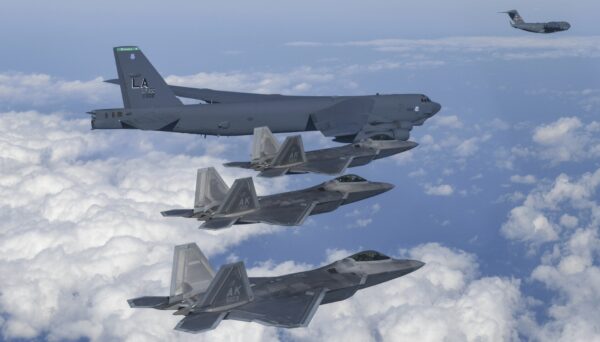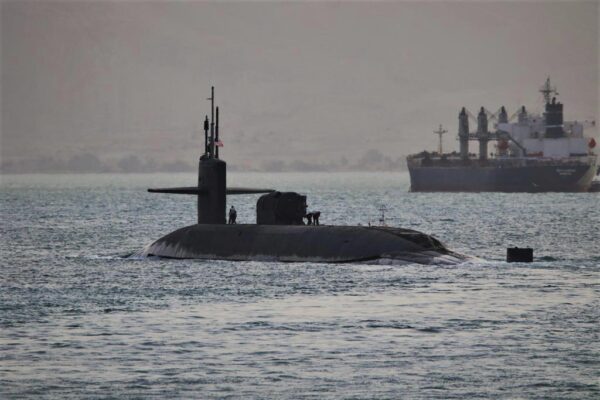


The United States has had no success in persuading Kim Jong Un’s North Korean regime to denuclearize, but a new deal in reaffirming a 70-year treaty will keep South Korea from building its own nuclear arsenal.
In exchange for South Korea’s commitment to remain in compliance with the Nuclear Nonproliferation Treaty, the United States will double down on the “nuclear” component of its “nuclear deterrence” strategy against the Democratic People’s Republic of Korea (DPRK).
The shift from “denuclearization” to “nuclear deterrence” in dealing with North Korea was the key distinction in the ‘Washington Declaration’ unveiled by U.S. President Joe Biden and Republic of Korea’s (ROK) Yoon Suk Yeol after a ceremony commemorating the 70th anniversary of the US-ROK alliance in Washington on April 26.
Speaking in the Rose Garden, Biden said one thing will remain the same: Any use of a nuclear weapon against the United States or its allies “will result in the end of whatever regime takes such an action.”
The declaration acknowledges the 30-year effort to prevent Pyongyang from developing nuclear weapons has failed and outlines a suite of “extended deterrence” measures the United States and ROK will take to counter North Korea’s nuclear saber-rattling.
The revised treaty spells out that “extended deterrence” means a “more visible” presence of U.S. nuclear assets in the region in a “regular deployment of strategic assets,” which will include the first South Korean port visits of U.S. Navy 7th Fleet’s “boomers”—large submarines that carry nuclear submarine-launched ballistic missiles (SLBMs)—in four decades.
“We are not going to be stationing nuclear weapons on the peninsula. We will have port visits by nuclear submarines and things like that,” Biden said.
International Assessment and Strategy Center Senior Fellow Rick Fisher called the commitment to move nuclear assets in and out of the region on deployments not the same thing as putting them in North Korea’s face across the 38th parallel separating the two countries.
“The Biden administration’s decision to deploy a nuclear warhead armed ballistic missile submarine for deterrence missions in Northeast Asia is a less-than-optimal substitute for deploying and reviving the U.S. theater nuclear arsenal in Asia, and strategically amounts to ‘stealing from Peter to pay Paul,’” Fisher told The Epoch Times.
The declaration strengthens joint training exercises and simulation activities to improve U.S.-ROK deterrence in “defending against DPRK threats, including by better integrating ROK conventional assets into our strategic plan.”
In other words, it allows military planners to combine U.S. strategic forces, such as B-52 bombers, in tandem with ROK conventional forces.
The agreement creates a U.S.-ROK Nuclear Consultative Group to serve as a “regular bilateral dialogue mechanism” which will “reaffirm our commitment to make every effort to consult with the ROK in potential nuclear crises,” White House officials said in an April 25 background brief.
Yoon said the group establishes “president-level” consultation and allows South Korean military planners to have input on how, and if, the United States would use nuclear weapons against North Korea as part of the “extended deterrence” doctrine.
“We want to customize our response against North Korea’s nuclear threat to extended deterrence,” Yoon said. With ROK military leaders now participating in decisions regarding nuclear weapons at the “implementation level, it is definitely higher than in the past. We would jointly plan responses, exercises, and drills and implementation.”
The “extended deterrence” measures are not only designed to be more visible to Kim Jong Un, but to the South Korean public, which has been rattled by North Korea’s intensifying missile tests and saber-rattling rhetoric amid concerns about partisan division paralyzing the United States from making intelligent decisions.
The United States feared South Korea’s dalliance with adding a nuclear component to its already robust, and well-drilled, arsenal could encourage further proliferation to Japan and, perhaps, Southeast Asia nations.
South Korea, which abandoned its nuclear weapons development program in the 1960s, joined the Nuclear Nonproliferation Treaty (NPT) in 1975. But increasingly, South Koreans favor the nation building its own nuclear arsenal. According to a 2022 poll, 71 percent of South Koreans backed the development of a domestic nuclear weapons program.
At a January event in Seoul, Yoon mused that ROK could build its own nuclear weapons or ask the United States to redeploy nuclear weapons in South Korea. It did so during the Cold War era.
But Yoon said in the Rose Garden that the “extended deterrence” in the Washington Declaration should assuage some of that agitation.
“Any concerns Koreans have about nuclear weapons will be relieved, I believe,” he said.
Merely restating that commitment out loud is a deterrent in itself, said Liberty University Dean Morse Tan, a former U.S. Ambassador to ROK. “I think the U.S. commitment to defend South Korea has been the largest deterrent against another full-blown Korean war and aggression on the part of North Korea,” he told NTD, sister media to The Epoch Times.
Biden said the declaration reaffirms the United States’ “iron-clad commitment” to “countering North Korea threats and blatant violations of U.S. sanctions” although, he added, the United States will continue to ”seek a diplomatic breakthrough to bolster stability, [to] reduce the threat of proliferation” on the Korean peninsula.
The 70th anniversary of the U.S.-ROK alliance marks the fourth time Biden and Yoon have met since Biden took office in January 2021. After addressing Congress on April 27, Yoon will conclude his six-day on April 28.
Biden said he also spoke with Yoon about their common interests in ensuring safe commercial ship transit through the Strait of Taiwan and in expressing concern about the Peoples Republic of China’s increasing aggressive actions in the South China Sea.
Although the PRC subsidizes the North Korean regime, China is South Korea’s largest trading partner. These close commercial relationships can obscure the danger the CCP poses in threatening to invade Taiwan and control South China Sea shipping, Tan said.
“North Korea is propped up by China,” he said, adding that the CCP’s support for North Korea’s intimidation of South Korea, and its threats against Taiwan are “very much connected.”
“There has to be an awareness and there has to be strong and firm determination to counter these sorts of aggressive designs” by western Pacific democracies, Tan said. “I think there is the capability to be able to stand up to the designs of the Chinese Communist Party and the North Korean regime on Taiwan and North Korea respectively.”
Fisher, an Epoch Times contributor, said allowing the U.S. Navy’s SLBM “boomers” to be “more visible” for North Korea’s—and the PRC’s—benefit, will have repercussions on how the United States moves around its 15,000 deployed nuclear warheads.
“America’s [nuclear SLBM submarine] fleet is already hard-pressed to deter a growing Russian and burgeoning Chinese nuclear missile arsenal, perhaps growing in excess of 3,000, at a time when China and Russia are tempted to initiate, if they haven’t already, cooperative nuclear coercive and even first-strike operations against the United States,” he said in an email.
“Boomers” generally deploy to the Arctic and stay hidden under the ice cap, or other deep crevices in ocean floors, awaiting a signal to launch SLBMs. They are often described as world-enders and deliver a huge strategic advantage to the United States as part of its triad nuclear strategy.
Deploying such a big missile boat into the Western Pacific “brings it closer to Russian and Chinese nuclear attack submarines,” Fisher said, “which means the U.S. Navy has to devote very valuable U.S. nuclear attack subs for escort duty, when they could be needed in a flash to combat a Chinese invasion of Taiwan.”
He said if the U.S. nuclear strategic arsenal is “to do its first job, prevent China, Russia, and now North Korea, from launching a surprise first strike against American cities,” it must do more than offer “extended deterrence.”
“America desperately requires a much larger tactical nuclear force, deployed in tactical nuclear bombs, and missiles and cruise missiles with small nuclear warheads, to deter North Korea’s overwhelming nuclear and conventional invasion threat to South Korea and China’s nuclear and conventional existential threat to Taiwan.],” Fisher said.
The Biden administration’s “refusal to rebuild and deploy a revived U.S. theater nuclear force for myopic ideological reasons is simply the surest way to convince North Korea, China, and Russia that they can initiate wars because the U.S. will be deterred at the theater and strategic levels,” he said.



